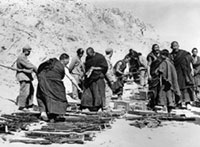




When Chinese troops suppressed a nationalist uprising in Tibet’s capital city Lhasa in 1959, a curtain came down over Tibet. Thousands were killed in fighting across the country or vanished into labor camps and jails—where many died from illness, overwork, or starvation.
Now, a Tibetan survivor of those events has released an account of them in English translation.
Tubten Khetsun’s Memories of Life in Lhasa Under Chinese Rule , published in 2008 by Columbia University Press, details the author’s experiences in Chinese prisons and as a forced laborer on state-run construction sites and farms from 1959-79.
Written and published originally in Tibetan, the book was translated into English by Matthew Akester, a British scholar of Tibetan studies.
“It’s very important to have a written record of what took place,” said Khetsun, speaking at a private gathering in Virginia to mark the book’s release. “My generation suffered a lot, and I wanted to talk about the truth so that future generations will know what happened.”
The story itself is quite dramatic and moving, and he tells it well.
Khetsun’s recollections form a vast chronicle of suffering—told in dispassionate tones but also in surprising detail. “For someone who has been through this kind of situation,” Khetsun said, “even if you want to forget, you can’t forget.”
Moved from one place of confinement to another in the months following the failed uprising, Khetsun—then 18, and having just finished training for government service—endured interrogation, hunger, beatings, and dangerous work conditions as he and fellow prisoners gathered and burned dead bodies, cleared construction sites, and fought continual exhaustion.
Many, Khetsun writes, gave in to despair and “killed themselves in one way or another, by jumping in the river or throwing themselves off a cliff or under the wheels of a truck.”
Political indoctrination was a constant theme, with Chinese officers and guards relentlessly attacking the culture and social values of “old,” pre-communist Tibet.
In later chapters, the book describes factional fighting in Tibet during the 1966-76 Cultural Revolution, the destruction of Tibet’s famous Ganden monastery, and a succession of campaigns, little known in the West, by Chinese authorities to root out perceived “class enemies” among Tibetans.
Tubten Khetsun, who left Tibet in 1983 and moved to the United States, said his Buddhist faith helped him through his ordeal.
“The most important thing was that His Holiness the Dalai Lama was able to flee and was able to reside in India,” Khetsun said. “That was a source of hope for me and for everyone in the prison at that time.”
Memories of Life in Lhasa Under Chinese Rule is the first book of its kind to appear in English that was written personally, and in Tibetan, by “an educated person from the middle-level elites,” said Tibet expert Robert Barnett, who had urged the book’s publication by Columbia University Press.
“That was my argument for getting them to publish it,” said Barnett, director of Columbia University’s Modern Tibetan Studies Program.
Anne Routon, the book’s editor at Columbia University Press, said that in first looking over the manuscript, she was impressed by its “even, unembellished, unencumbered, clean narrative tone.”
“The story itself is quite dramatic and moving, and he tells it well,” Routon said.
Barnett said that following brutal and well-publicized crackdowns in the late 1980s in the wake of Tibetan protests against Chinese rule, there is now “incredibly little information” being collected on conditions inside Chinese jails, prisons, and labor camps in Tibet.
“I think that they probably have brought some kind of control to most cases in Lhasa, in terms of torture,” said Barnett. “But that control probably disintegrates whenever there’s an ‘event.’ And then the beatings are very bad.”
“But I think outside Lhasa, there could still be a lot of torture quite regularly.”
Even in Lhasa, though, police still beat people in the street, Barnett said.
“I think they feel they’re entitled to be really brutal, and I’m not sure what sense of limit they have to that. Maybe a bit more in a Lhasa prison, a lot less in a Lhasa detention center, and maybe not much at all outside the city.”
The U.S. Congressional-Executive Commission on China, in its annual report for 2007, cited 100 “known cases of current Tibetan political detention or imprisonment as of September 2007, a figure that is likely to be lower than the actual number of Tibetan political prisoners.”
“Chinese authorities continue to detain and imprison Tibetans for peaceful expression and non-violent action, charging them with crimes such as ‘splittism,’ and claiming that their behavior ‘endangers state security,’” the Commission said.
Original reporting by Richard Finney in Washington. Edited and produced in English by Sarah Jackson-Han.